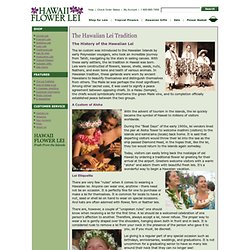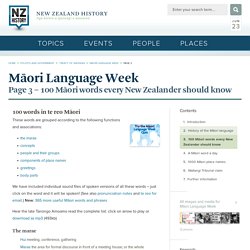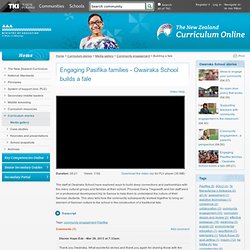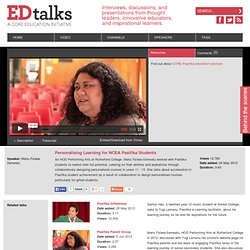

Māori Dictionary. Murihiku Polyfest. Murihiku Polyfest. Hawaii History - the Tradition of the Hawaiian Lei. The lei custom was introduced to the Hawaiian Islands by early Polynesian voyagers, who took an incredible journey from Tahiti, navigating by the stars in sailing canoes.

With these early settlers, the lei tradition in Hawaii was born. Leis were constructed of flowers, leaves, shells, seeds, nuts, feathers, and even bone and teeth of various animals. In Hawaiian tradition, these garlands were worn by ancient Hawaiians to beautify themselves and distinguish themselves from others. The Maile lei was perhaps the most significant. Among other sacred uses, it was used to signify a peace agreement between opposing chiefs. A Custom of Aloha With the advent of tourism in the islands, the lei quickly became the symbol of Hawaii to millions of visitors worldwide.
During the "Boat Days" of the early 1900s, lei vendors lined the pier at Aloha Tower to welcome malihini (visitors) to the islands and kama'aina (locals) back home. 100 Māori words every New Zealander should know. 100 words in te reo Māori These words are grouped according to the following functions and associations: We have included individual sound files of spoken versions of all these words – just click on the word and it will be spoken!

(See also pronunciation notes and te reo for email.) New: 365 more useful Māori words and phrases Hear the late Tairongo Amoamo read the complete list: click on arrow to play or download as mp3 (493kb) Māori Language Week homepage - Kōrero Māori. Ko te Ara Mahi/Your career. Culturally Responsive Teaching. Personalising Learning for NCEA Pasifika Students. In my role as HOD Performing Arts I oversee music, drama and dance and in that capacity I make sure that our subjects offer opportunities to our students.

We deliberately have discussions that...we group together standards that we know play to the strengths of our Pasifika students so that they can not only Achieve but gain Excellence credits. And also, when we create pathways like that, we’re creating programmes where we’re aiming for Excellence and not trying to teach them things that they have no way of passing because they lack the prior knowledge or they haven’t had the opportunities that say decile 10 school children would have had. Useful language for the classroom / Teachers' notes / Homepage - He reo tupu, he reo ora. Culturally Responsive Teaching. Building a fale / Community engagement / Media gallery / Curriculum stories. Transcript The teachers and the principal went to Samoa.

I believe it was back in 2006. They went and visited some schools in Samoa and, you know, just that whole experience really opened their eyes to how, you know, how the children really - a culture can really make a difference to learning of our children back here in Owairaka School. So Diana took on the reins of having this vision of having her own fale Samoa here at the school and she approached our Samoan support group and we just went, ‘Oh yes!’
We loved it, why not? A culturally connected curriculum / Treaty of Waitangi / Media gallery / Curriculum stories. ABC Online Indigenous - Interactive Map. Developing cultural competencies for teachers of Māori students. A tool to help develop the cultural competence of teachers of Māori students was piloted during 2011–2012.

KATE BLEASDALE looks at case studies of the schools that participated in Tātaiako. As well as developing cultural competence, Tātaiako: Cultural Competencies for Teachers of Māori Learners aims to help educators develop better relationships with whānau, hapū, and iwi in their school community, as well as with Māori students. The programme was developed by the Ministry of Education and the New Zealand Teachers Council (NZTC) at the request of the Associate Minister of Education, Dr Pita Sharples.
Tātaiako is a Ka Hikitia-derived resource and a workforce development tool for use by individual teachers, ITEs (initial teacher education providers), schools, ECE services, the Ministry, NZTC, ERO (Education Review Office), and iwi. Planning the pilot Given the kaupapa of Tātaiako is about engagement, a kanohi ki te kanohi (face-to-face) approach was chosen. Model for Supporting Student Motivation to Learn.
Readings & Research. Personalising Learning for NCEA Pasifika Students. In my role as HOD Performing Arts I oversee music, drama and dance and in that capacity I make sure that our subjects offer opportunities to our students.

We deliberately have discussions that...we group together standards that we know play to the strengths of our Pasifika students so that they can not only Achieve but gain Excellence credits. And also, when we create pathways like that, we’re creating programmes where we’re aiming for Excellence and not trying to teach them things that they have no way of passing because they lack the prior knowledge or they haven’t had the opportunities that say decile 10 school children would have had.
But in saying that, we try and offer them as much opportunity to see places outside of school, or we bring visitors in so we expose the students to as much as possible. As a music teacher, because of the line I take with my staff, I’m able to have the same with my own classroom. Increasing Student Engagement Through - trialling-and-evaluating-a-strengths-based-student-engagement-framework.pdf.
Culturally Responsive Teaching.